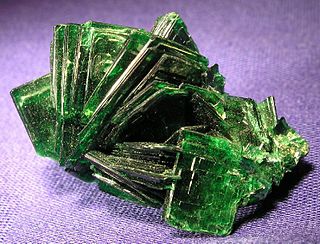
First Quantum Minerals is a Canadian-based mining and metals company whose principal activities include mineral exploration, development and mining. Its main product is copper, which accounts for 80% of revenues as of 2016.

The mining industry of the Democratic Republic of the Congo produces copper, diamonds, tantalum, tin, gold, and more than 63% of global cobalt production. Minerals and petroleum are central to the DRC's economy, making up more than 95% of the value of its exports.
The Dikulushi mine is a copper and silver mine in the Democratic Republic of the Congo. It is located some 23 kilometres (14 mi) west of Lake Mweru and 50 kilometres (31 mi) north of Kilwa in the Moero Sector of Pweto Territory, Katanga Province.
Bisie, divided into Mpama North and Mpama South deposits, is a tin deposit in the Walikale territory of the province of North Kivu in the Democratic Republic of the Congo (DRC). The mine was formerly an illegal source of an estimated 15,000 tons of tin, or 4% of global production. In early 2018 artisanal mining activity has stopped, and Alphamin Resources Corp., an exploration company, based in Mauritius, is leading an exploration of the site.

Pweto is a town in the Haut-Katanga Province of the Democratic Republic of the Congo (DRC). It is the administrative center of Pweto Territory. The town was the scene of a decisive battle in December 2000 during the Second Congo War which resulted in both sides making more active efforts to achieve peace. Pweto and the surrounding region were devastated during the war. As of 2011 little had been done to restore infrastructure or rebuild the economy. The town is served by Pweto Airport.

Pweto Territory is a territory in the Haut-Katanga Province of the Democratic Republic of the Congo (DRC). The headquarters are in the town of Pweto.
Pweto Airport is an airport serving Pweto, a town in the Democratic Republic of the Congo. Pweto is on the northernmost corner of Lake Mweru, and on the border with Zambia.
Moero Sector is an administrative division of Pweto Territory in Haut-Katanga Province of the Democratic Republic of the Congo (DRC). The headquarters are in the town of Kilwa.

Anvil Mining was a copper producer that has been operating in the Democratic Republic of the Congo (DRC) from 2002 to 2012. The company headquarters were in Montreal, Quebec, Canada. Anvil was listed on the Toronto Stock Exchange and the Australian Stock Exchange. As of September 2011 its major shareholder was Trafigura Beheer.
Kinsevere is an open pit mine and Heavy Media Separation plant with an electric arc furnace formerly operated by Anvil Mining, and now operated by Minerals and Metals Group. It is located 30 kilometres (19 mi) north of Lubumbashi, Katanga Province, Democratic Republic of Congo.
Copper mining in the Democratic Republic of the Congo mainly takes place in the Copper Belt of the southern Katanga Province of the Democratic Republic of the Congo.

The Musonoi mine is a set of open-cut pits near Kolwezi from which copper and other metals have been extracted since the 1940s. The mining complex is located in the Lualaba Province of the Democratic Republic of the Congo. Kolwezi is about 320 kilometres (200 mi) northwest from Lubumbashi, the provincial capital.
The Kolwezi tailings project also known as the Roan Tailings Reclamation is a project in the Kolwezi mining area of the Democratic Republic of the Congo (DRC) to recover copper from the tailings, or processed ore, from mining in the region since the 1950s. The project was developed by the Canadian mining companies Adastra Minerals and then First Quantum Minerals between 2004 and 2009, when the DRC government revoked First Quantum's license. The project is currently majority owned by the Eurasian Resources Group.

Shituru is a town that is now a commune of the city of Likasi in Haut-Katanga province, Democratic Republic of the Congo. It is also the location of a copper mine, smelter and hydrometallurgical plant that was operated by the state-owned Gécamines.
Mutoshi Mine is a copper mine in Katanga Province, Democratic Republic of the Congo. As of 2011 it was 70% owned by Anvil Mining and 30% by the state-owned Gécamines. The mine was placed on care and maintenance in late 2008.
The Ruashi Mine is an open-pit copper and cobalt mine operated by Metorex that is located about 10 kilometres (6.2 mi) from Lubumbashi in Katanga Province, Democratic Republic of the Congo. The project includes a plant to concentrate the ore from the Ruashi and Etoile mines, and a modern solvent extraction electrowinning (SX-EW) processing plant. As of 2008, annual capacity was estimated to be 10,000 tonnes of copper and 1,000 tonnes of Cobalt.
The Musoshi Mine is an underground copper mine in the Katanga Province of the Democratic Republic of the Congo. The mineral rights are owned by the South African miner Metorex.
Mashamba East is an open pit copper mine near to Kolwezi in Katanga Province, Democratic Republic of the Congo. As of 2014, the mine was not currently not being actively worked.
Kalukundi Mine is a copper and cobalt mine being developed in Katanga Province, Democratic Republic of the Congo (DRC) by Africo Resources, a Canadian company. In September 2008 the company estimated the value of the resource as $1.47 billion.
Géomines was a Belgian mining company active in the Belgian Congo and then in the Democratic Republic of the Congo. It was established in 1910, and exploited a large deposit in the southeast of the country to become one of the largest tin producers in the world. It was taken over by Zairetain in 1968.






